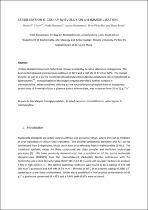 ResearchSpace
ResearchSpace
Stabilization of Escherichia coli uridine phosphorylase by evolution and immobilization
JavaScript is disabled for your browser. Some features of this site may not work without it.
- ResearchSpace
- →
- Research Publications/Outputs
- →
- Journal Articles
- →
- View Item
| dc.contributor.author |
Visser, Daniel F

|
|
| dc.contributor.author |
Hennessy F

|
|
| dc.contributor.author |
Rashamuse J

|
|
| dc.contributor.author |
Pletschke B

|
|
| dc.contributor.author |
Brady D

|
|
| dc.date.accessioned | 2011-07-19T12:37:05Z | |
| dc.date.available | 2011-07-19T12:37:05Z | |
| dc.date.issued | 2010-08 | |
| dc.identifier.citation | Visser, DF, Hennessy, F, Rashamuse, J, et al. 2011. Stabilization of Escherichia coli uridine phosphorylase by evolution and immobilization. Journal of Molecular Catalysis B: Enzymatic, Vol. 68(3/4), pp. 279-285 | en_US |
| dc.identifier.issn | 1381-1177 | |
| dc.identifier.uri | http://www.sciencedirect.com/science/article/pii/S1381117710003012 | |
| dc.identifier.uri | http://hdl.handle.net/10204/5109 | |
| dc.description | Copyright: 2010 Elsevier Publishers. This is a pre print version of the work. The definitive version is published in the Journal of Molecular Catalysis B: Enzymatic, Vol. 68(3/4), pp. 279-285 | en_US |
| dc.description.abstract | Uridine phosphorylase from Escherichia coli was evolved by iterative saturation mutagenesis. The best mutant showed a temperature optimum of 60C and a half-life of 17.3 h at 60C. The mutant enzyme, as well as a purine nucleoside phosphorylase from Bacillus halodurans, were immobilised as SpherezymesTM. Immobilisation of the mutant enzyme provided a further increase in thermostability. When combined with the purine nucleoside phosphorylase from B. halodurans, productivity of 5-methyluridine, a pharmaceutical intermediate, was increased from 10 to 31 g.l-1.h-1. | en_US |
| dc.language.iso | en | en_US |
| dc.publisher | Elsevier Publishers | en_US |
| dc.relation.ispartofseries | Workflow;4619 | |
| dc.subject | Biocatalysis | en_US |
| dc.subject | Transglycosylation | en_US |
| dc.subject | Directed evolution | en_US |
| dc.subject | Immobilisation | en_US |
| dc.subject | Spherezyme | en_US |
| dc.subject | 5-methyluridine | en_US |
| dc.title | Stabilization of Escherichia coli uridine phosphorylase by evolution and immobilization | en_US |
| dc.type | Article | en_US |
| dc.identifier.apacitation | Visser, D. F., Hennessy F, Rashamuse J, Pletschke B, & Brady D (2010). Stabilization of Escherichia coli uridine phosphorylase by evolution and immobilization. http://hdl.handle.net/10204/5109 | en_ZA |
| dc.identifier.chicagocitation | Visser, Daniel F, Hennessy F, Rashamuse J, Pletschke B, and Brady D "Stabilization of Escherichia coli uridine phosphorylase by evolution and immobilization." (2010) http://hdl.handle.net/10204/5109 | en_ZA |
| dc.identifier.vancouvercitation | Visser DF, Hennessy F, Rashamuse J, Pletschke B, Brady D. Stabilization of Escherichia coli uridine phosphorylase by evolution and immobilization. 2010; http://hdl.handle.net/10204/5109. | en_ZA |
| dc.identifier.ris | TY - Article AU - Visser, Daniel F AU - Hennessy F AU - Rashamuse J AU - Pletschke B AU - Brady D AB - Uridine phosphorylase from Escherichia coli was evolved by iterative saturation mutagenesis. The best mutant showed a temperature optimum of 60C and a half-life of 17.3 h at 60C. The mutant enzyme, as well as a purine nucleoside phosphorylase from Bacillus halodurans, were immobilised as SpherezymesTM. Immobilisation of the mutant enzyme provided a further increase in thermostability. When combined with the purine nucleoside phosphorylase from B. halodurans, productivity of 5-methyluridine, a pharmaceutical intermediate, was increased from 10 to 31 g.l-1.h-1. DA - 2010-08 DB - ResearchSpace DP - CSIR KW - Biocatalysis KW - Transglycosylation KW - Directed evolution KW - Immobilisation KW - Spherezyme KW - 5-methyluridine LK - https://researchspace.csir.co.za PY - 2010 SM - 1381-1177 T1 - Stabilization of Escherichia coli uridine phosphorylase by evolution and immobilization TI - Stabilization of Escherichia coli uridine phosphorylase by evolution and immobilization UR - http://hdl.handle.net/10204/5109 ER - | en_ZA |





